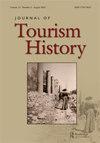From queen of seaside resorts to expulsion corridor: monitoring the entry, stay, and expulsion of foreigners in Ostend (1838–1914)
IF 0.3
Q4 HOSPITALITY, LEISURE, SPORT & TOURISM
引用次数: 0
Abstract
ABSTRACT International migration and tourism developed into cornerstones of modern societies and have many common features: they generally pass through the same routes, are served and controlled by similar actors, and often depend on each other as for instance with the prevalence of migrant labour in the tourism industry. Despite these entanglements which sometimes blur the lines between tourists and migrants, there has been very little scholarly attention aimed at connecting both fields, not least from a historical perspective. Using sources generated by the Foreigners Police, a body responsible for monitoring all non-nationals in Belgium and expelling ‘undesirables’, this article analyses how mobility controls addressing tourists and migrants evolved in Ostend, one of the most prominent European tourist resorts during the nineteenth century. This article tests how mobility controls in resorts deviated from national guidelines and explores whether security concerns about controlling foreigners weighed up against economic benefits derived from international mobility. How did authorities differentiate tourists from migrants and to what extent did mobility controls of migrants overlap and differ with those addressing tourists? By exploring the entanglements between mobility and migration controls the article seeks to encourage tourism and migration scholars to engage in broader debates.从海滨度假胜地女王到驱逐走廊:监控外国人在奥斯坦德的入境、停留和驱逐(1838–1914)
摘要国际移民和旅游业已发展成为现代社会的基石,并具有许多共同特征:它们通常通过相同的路线,由相似的行为者提供服务和控制,并且往往相互依赖,例如旅游业中移民劳动力的盛行。尽管这些纠葛有时会模糊游客和移民之间的界限,但学术界很少关注将这两个领域联系起来,尤其是从历史的角度来看。本文利用外国人警察局提供的信息来源,分析了19世纪欧洲最著名的旅游胜地之一奥斯坦德针对游客和移民的流动控制是如何演变的。本文测试了度假胜地的流动控制是如何偏离国家指导方针的,并探讨了控制外国人的安全问题是否与国际流动带来的经济利益相权衡。当局如何区分游客和移民,对移民的流动控制在多大程度上与针对游客的控制重叠和不同?通过探索流动性和移民控制之间的纠缠,本文试图鼓励旅游和移民学者参与更广泛的辩论。
本文章由计算机程序翻译,如有差异,请以英文原文为准。
求助全文
约1分钟内获得全文
求助全文
来源期刊

Journal of Tourism History
HOSPITALITY, LEISURE, SPORT & TOURISM-
CiteScore
0.60
自引率
0.00%
发文量
16
期刊介绍:
The Journal of Tourism History is the primary venue for peer-reviewed scholarship covering all aspects of the evolution of tourism from earliest times to the postwar world. Articles address all regions of the globe and often adopt interdisciplinary approaches for exploring the past. The Journal of Tourism History is particularly (though not exclusively) interested in promoting the study of areas and subjects underrepresented in current scholarship, work for example examining the history of tourism in Asia and Africa, as well as developments that took place before the nineteenth century. In addition to peer-reviewed articles, Journal of Tourism History also features short articles about particularly useful archival collections, book reviews, review essays, and round table discussions that explore developing areas of tourism scholarship. The Editorial Board hopes that these additions will prompt further exploration of issues such as the vectors along which tourism spread, the evolution of specific types of ‘niche’ tourism, and the intersections of tourism history with the environment, medicine, politics, and more.
 求助内容:
求助内容: 应助结果提醒方式:
应助结果提醒方式:


